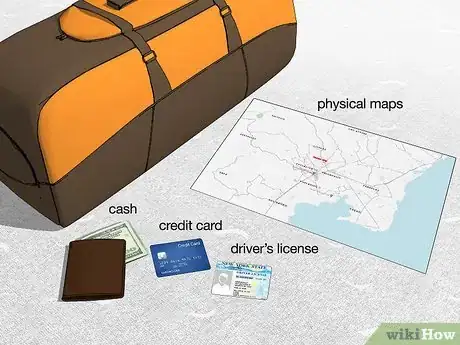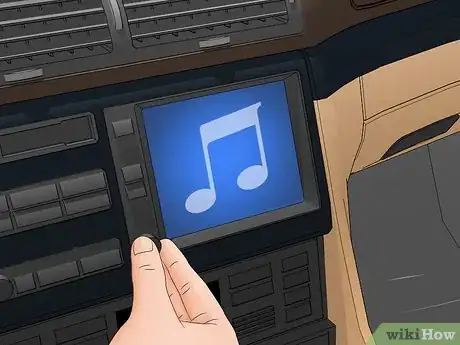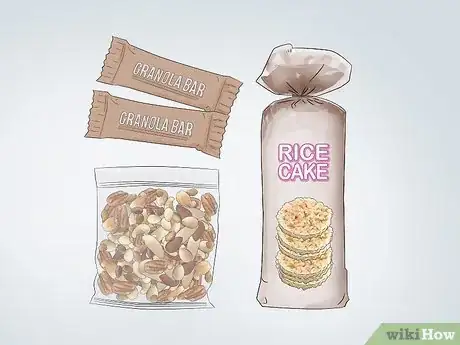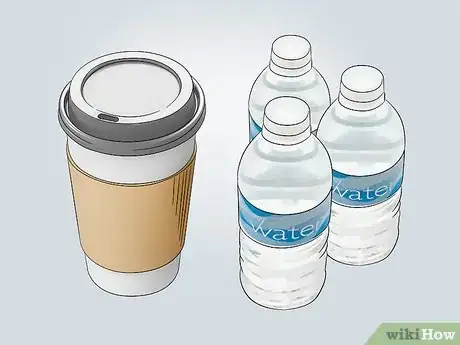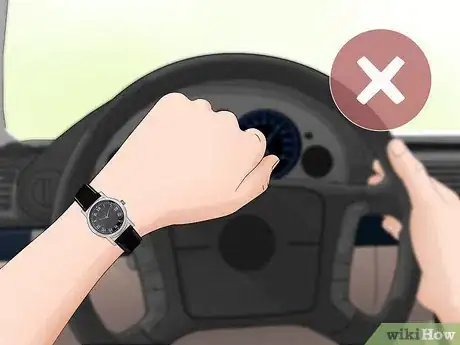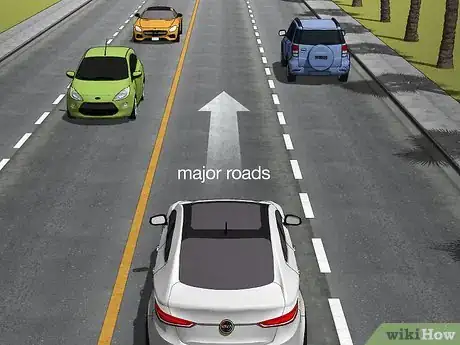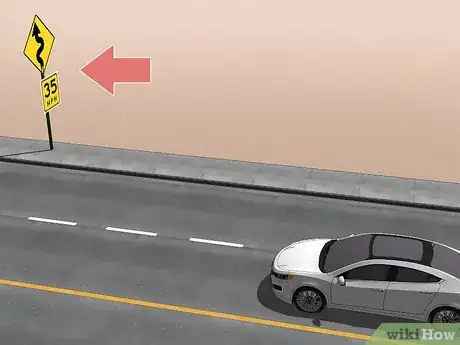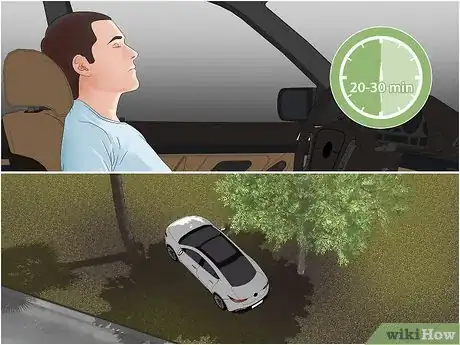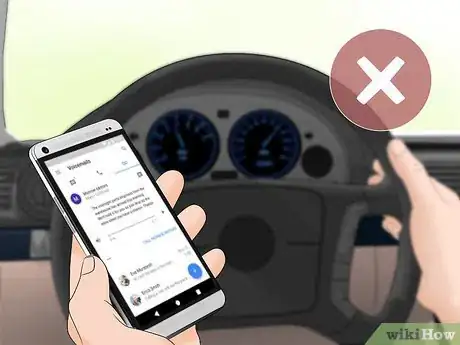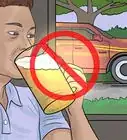This article was co-authored by American Automobile Association and by wikiHow staff writer, Jessica Gibson. The American Automobile Association (also known as "AAA" or "Triple A") is a federation of motor clubs throughout North America and a non-profit organization focused on the safety of the driving public and the future of mobility. Best known for providing its members with roadside assistance, AAA has also been providing auto repair services and insurance for auto, home, life, and business for over a century. Founded in 1902, AAA is headquartered in Heathrow, Florida.
There are 10 references cited in this article, which can be found at the bottom of the page.
This article has been viewed 326,634 times.
If you're feeling anxious about taking a big trip alone, look at the drive as an opportunity to enjoy some time to yourself. As long as you plan for traveling and prepare for emergencies, you should safely manage the drive. Pack snacks, dress comfortably, and bring your favorite music. Then, relax and enjoy the solitude as you put the miles behind you.
Steps
Getting Ready for a Trip
-
1Plan your route and include stopping points. Decide which main roads you'll take to get to your destination and pick any places of interest you want to see along the way. Even if you're trying to drive straight to your destination, make notes of rest stops along the route. It's important to plan even if you'll be using your GPS since you might lose the signal or run out of battery.[1]
- If you're driving for several days, make an itinerary for how far you want to drive each day. For example, you might want to drive 7 hours for the first day, but only drive 5 hours the next.
-
2Pack your car with everything you need for the trip. In addition to your luggage, bring a little cash along with your credit cards. Remember to have your license and proof of car insurance in your vehicle. It's also a good idea to pack physical maps even if you'll be relying on your car or phone's GPS.[2]
- If you're crossing borders, check that your passport is still valid and pack it in a safe place in the car.
- Don't forget your phone charger, especially if you're using the phone a lot to navigate.
Advertisement -
3Schedule a car inspection before your trip. In the week before you travel, get your car looked at by a mechanic and ask them if there are any issues to fix. Getting your car in shape could prevent mechanical emergencies during your trip. You might need to get an oil change, top up the fluids, replace an air filter, or get new tires, for instance.[3]
- Do this well before your trip so you can schedule additional maintenance as needed.
-
4Load the car with emergency car supplies. No one wants to experience a flat tire or road emergency, but it's best to be prepared. Pack a spare tire along with any other supplies you might need. For example, if you're traveling through a hot location and worry that your car might overheat, pack a jug of water or coolant. Consider traveling with:[4]
- Jumper cables
- Flashlights
- First aid kit
- Simple tool kit
- Blanket or sleeping bag
-
5Inform family and friends about your plans. Since you'll be traveling alone, it's important to let people close to you know where you'll be. Tell them your route, let them know when you'll be passing through each destination, and tell them you'll contact them along the way.[5]
- Email the info or write it down so your family or friends can refer back to the information.
Tip: You might want to have your friends or family check on your place while you're gone. Give them keys so they can get into your home if necessary.
Making the Drive Enjoyable
-
1Wear comfortable clothes so you feel relaxed. Avoid dressing in tight, restrictive clothing since you'll be sitting for a long time. Choose light, loose fabrics that allow you to move easily. Layer your clothes so you can stay warm or cool during your drive.[6]
- If you start driving in the morning when it's cool, you might want a fleece jacket. You can remove it later when you warm up or drive to a hotter destination.
-
2Listen to your favorite music. Load an MP3 player with a variety of your favorite music or pack plenty of CDs. Enjoying music is a great way to pass the time during a long drive.[7]
- If you don't like listening to music in the car, find an audiobook or podcast to enjoy.
Tip: See if your local library allows you to borrow CDs. This is a good way to enjoy some new music on the trip.
-
3Pack healthy snacks to munch on. Keep easy-to-eat snacks in the passenger seat so you can eat something when you feel hungry. Snacking on something healthy is also a good way to stay awake since it will help you focus on something. Avoid snacking on salty foods, which can dehydrate you. Good snack options include:[8]
- Granola bars
- Unsalted nuts
- Rice cakes
- Fresh fruit and vegetables
- Crackers
-
4Bring refreshing beverages to drink so you stay hydrated. Water is one of the best drinks for a long car ride, but you could also bring coffee, tea, caffeinated drinks, or juice. Avoid drinks with a lot of added sugar, such as energy drinks, which could make you jittery.[9]
- If you'd like the drinks to stay cool, put them into a small cooler and place it near the bottom of the passenger seat so it's easy to get to.
-
5Don't look at the clock to track how far you've driven. If you're in a hurry to get to your destination, glancing at the clock every few minutes will only make you more stressed. Make a point of not looking at the clock. Instead, relax and try to enjoy the drive.[10]
- Instead of focusing on how much longer you have in the car, think about how many miles you've put behind you.
Staying Safe While Driving Alone
-
1Take a popular route with major roads. Stick to your travel itinerary and avoid taking shortcuts. If you do need to take a detour, follow the detour signs closely. Don't take unmarked roads or routes that you're unsure of.[11]
- Stay on main roads so you can stop and ask for help if necessary.
- Adjust your travel plans if the weather worsens and you don't feel comfortable driving.
-
2Follow the local traffic laws and drive below the speed limit. Always wear your seat belt and be aware of your surroundings. Avoid speeding or breaking local traffic laws. Instead, drive cautiously and safely.[12]
- If you're driving into a foreign country, it's especially important to read about their driving laws since they might be very different than the ones you're used to.
-
3Pull off and take a short nap if you feel drowsy. Find a safe, well-lit location and park your car. Lock your doors and close your eyes for 20 to 30 minutes. It's better to take a little time to rest than risk getting into an accident by driving drowsy.
- Start your journey after a good night's sleep so you're less likely to be tired on the drive.
- Drink something caffeinated before you rest so you wake up feeling more energized.
Tip: To help you feel refreshed, open your windows every once in a while. The fresh air can help you stay alert.
-
4Avoid talking on the phone or texting while you drive. It's illegal to talk on a cell phone or text in many areas, so don't use your phone or you may get a ticket. Talking on the phone or texting distracts you when you should be focusing on your surroundings.[13]
- If you do need to take a call, pull off to a safe spot and have your conversation.
- Having a hands-free phone call is just as distracting as holding the phone up to your ear, so avoid using a headset to call someone.
-
5Take rest breaks to recharge. Getting out of the car for a few minutes to stretch your legs and use the restroom is a simple way to break up the drive. You can use these short breaks to contact friends or family and tell them where you're at.[14]
- Stop at designated rest stops or well-lit businesses. Avoid taking a break on the side of the road or in an unsafe area.
Community Q&A
-
QuestionHow effective are GPS devices while traveling?
 Community AnswerExtremely effective.
Community AnswerExtremely effective. -
QuestionWhat are some games I can play with myself?
 Community AnswerPlay the alphabet game. Find the letters of the alphabet in order using signs, billboards, advertising on trucks or license plates.
Community AnswerPlay the alphabet game. Find the letters of the alphabet in order using signs, billboards, advertising on trucks or license plates. -
QuestionHow can I stay awake while driving?
 Community AnswerDrink coffee or anything else with caffeine, keep it cold in your car, and turn the radio up.
Community AnswerDrink coffee or anything else with caffeine, keep it cold in your car, and turn the radio up.
Warnings
- Don't share personal details about yourself or your travel plans to strangers.⧼thumbs_response⧽
- Remember that each state and country has different laws. If you're traveling across borders, do some research about the local rules of the road.⧼thumbs_response⧽
References
- ↑ https://solotravelerworld.com/road-trip-alone/
- ↑ http://www.floridahealth.gov/newsroom/2014/09/092514-car-kit.html
- ↑ https://solotravelerworld.com/road-trip-alone/
- ↑ https://dps.mn.gov/divisions/hsem/weather-awareness-preparedness/Documents/emergency-kit-in-for-vehicles.pdf
- ↑ https://solotravelerworld.com/road-trip-alone/
- ↑ https://getaway.10best.com/13399992/what-to-wear-on-a-road-trip
- ↑ https://www.theroadtripexpert.com/entertain-yourself-on-a-long-car-ride/
- ↑ https://www.thetravel.com/10-foods-to-avoid-during-a-road-trip-and-10-that-are-a-good-idea/
- ↑ https://www.thetravel.com/10-foods-to-avoid-during-a-road-trip-and-10-that-are-a-good-idea/
- ↑ https://www.forbes.com/sites/nomanazish/2018/01/22/five-reasons-why-travel-is-good-for-your-mental-health/#39d9936c5934
- ↑ https://www.arrivealive.mobi/road-safety-for-women-driving-alone
- ↑ https://solotravelerworld.com/road-trip-alone/#13_Slow_Down_Go_Local_Radio_Diners_Diversions
- ↑ https://behavioralscientist.org/the-real-reason-you-shouldnt-text-while-driving/
- ↑ https://solotravelerworld.com/road-trip-alone/#13_Slow_Down_Go_Local_Radio_Diners_Diversions

